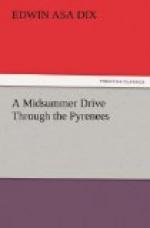[Illustration: THE LAC DE GAUBE AND THE VIGNEMALE.]
Other arrivals, two or three, are now at the inn, for the Lac de Gaube is a “required course” for all visitors to Cauterets. We are guilefully glad we preempted the trout. It is a very substantial little meal they serve, in this wilderness of rock and fir, where every supply except fish must be carried up, as it were, piecemeal. The proprietor does well in the catering line, but less well, he mourns to us, on his boats. It is that monument. The pale shaft is a constant memento mori. It suggests tragic possibilities. It always chills the tourist’s enthusiasm for a row, and generally freezes it altogether. With good reason, it seems, may mine host complain bitterly of its flattening effects on the boat-trade; and there is a dark whisper in Cauterets that, were the shaft not so closely enveloped both in religious sanctity and in municipal protection, it would some night mysteriously disappear.
VI.
The sun still blazes down upon the motionless lake, as we walk out once more for a long gaze toward the snows of the Vignemale. We try to trace out the route to its perilous summits, and conjecture the direction taken by Cantouz and Guilhembert when they made that grim first ascent; and our guide, approaching now with the horses, points out the direction afterward taken by Whymper and himself. We settle our account for the repast,—an account by no means exorbitant; wraps are re-cylindered and re-strapped, and we are soon on the return path downward through the woods. The saddles pitch like skiffs at sea. These Pyrenean horses are far more pronounced in their motions than the lowly Swiss mule. One by one the ladies dismount, and for the steep portions at least the horses go riderless, and no doubt secretly exult in their own shortcomings.
We pass the Pont d’Espagne, the roar of whose cataract is cheering the waiting hours of its solitary refreshment-seller. We plunge into the thicker leafage below, striding fast, or staying to lend hands from stone to stone or around the patches of wet ground. The woods echo with the noise of the brook, and now and then with the crack of a distant rifle; and finally we are down again to the first hut and taverner and the Cerizet fall. Now the ladies can spring comfortably up to their saddles once more, and the carriage-road is a welcome change from the lumpy bridle-path which we are leaving behind.




